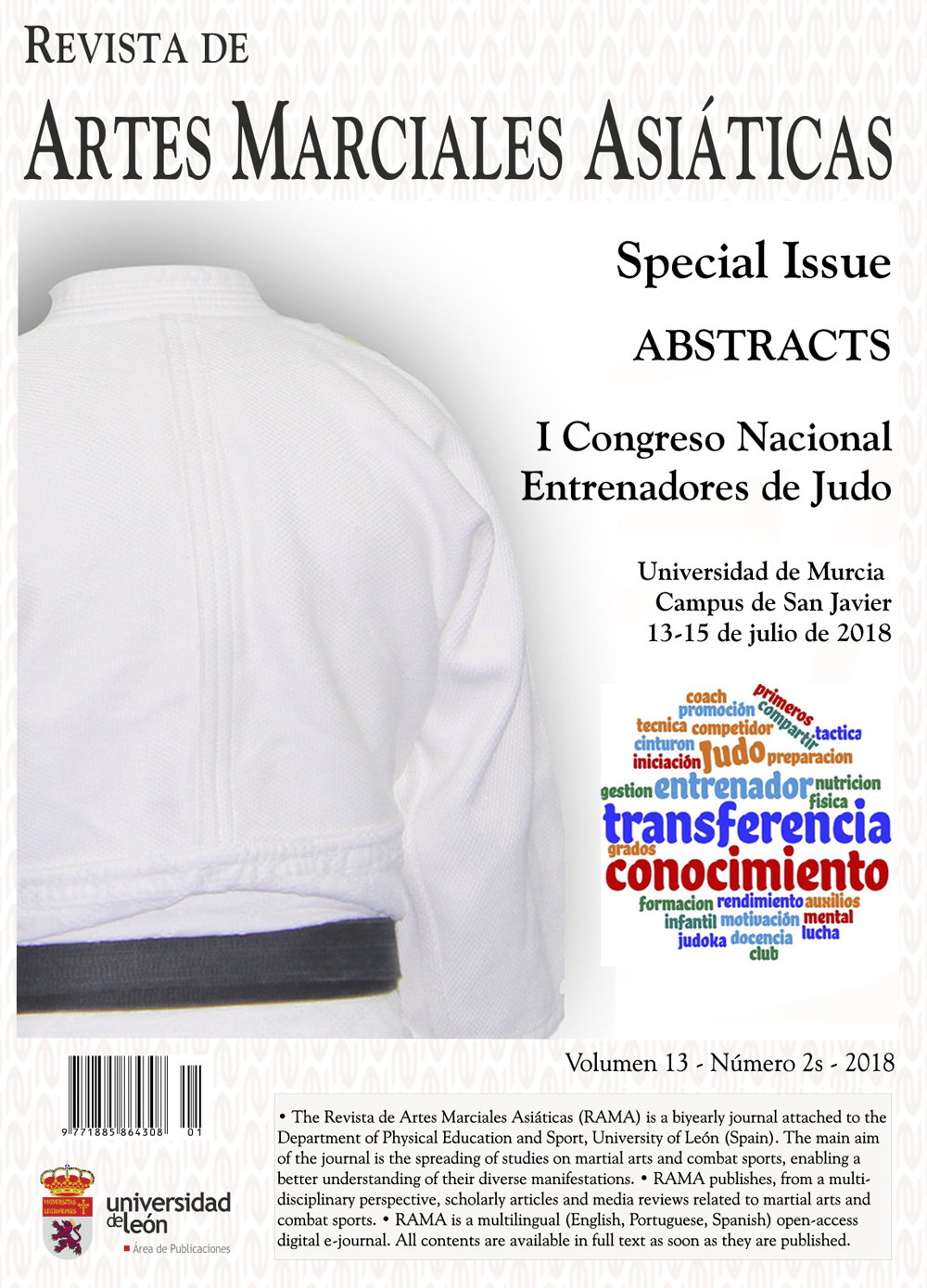Anxiety levels in judokas participating in the 41th Inter-Army Military Championship of Judo 2017
DOI:
https://doi.org/10.18002/rama.v13i2s.5502Keywords:
Judo, Anxiety, Inter-Army Military Judo Championships, Army, Guardia CivilAbstract
The aims of this study were: to describe the anxiety levels of competitive judokas who participated in the 41st Inter-army Military Championship of Judo, year 2017; to detect differences in anxiety levels depending on sex and weight categories; to explore if there was a relation between the anxiety levels and the judokas’ final results at the tournament. The sample was composed of 28 judokas (18 men and 10 women) belonging to two teams (Army and Guardia Civil), having an average age of 34.29 years (SD = 5.12). Before competition, the ISRA-B questionnaire, answers version, was administered. The results showed that judokas had lower levels of cognitive anxiety (p<.05), physiological anxiety (p<.001) and motor anxiety (p<.001) than other samples of athletes. Likewise, there were significant differences in anxiety levels according to sex, having women higher levels of motor anxiety in (p<.05). In terms of weight, only significant results were found in male judokas (p<.05), where the heavier judokas had higher levels of cognitive anxiety (p<.05). Only significant correlations were found between motor anxiety levels and the position obtained in competition in the male group (rho = -.635, p<.05). The results confirmed the necessity to perform differential psychological interventions considering the sex and weight category variables.
Downloads
Métricas alternativas
References
Andrade E.M., Lois, G., & Arce, C. (2007). Propiedades psicométricas de la versión española del Inventario de Ansiedad Competitiva CSAI-2R en deportistas. Psicothema, 19(1), 150-155.
García-Naveira, A., & Ruiz-Barquín, R. (2015). Adaptación del ISRA-B a la población deportiva a través de jugadores de fútbol de rendimiento. Ansiedad y Estrés, 21(1), 83-94.
Martens, R., Vealey, R. S., & Burton, D. (1990). Competitive anxiety in sport. Champaign, Il: Human Kinetics.
Miguel-Tobal, J.J., & Cano-Vindel, A.R. (2002). ISRA. Inventario de Situaciones y Respuestas de Ansiedad (5ª Edición).Madrid: TEA Ediciones.
Montero, C., Moreno, González, I., Pulido, J. J., & Cervelló, E. M. (2012). Ansiedad estado precompetitiva en judocas. Revista de Artes Marciales Asiáticas, 7(1), 26-43. doi: http://dx.doi.org/10.18002/rama.v8i2.977
Ruiz, R. (2005). Análisis de las diferencias de personalidad en el deporte del judo a nivel competitivo en función de la variable sexo y categoría de edad deportiva. Cuadernos de psicología del deporte, 5(1-2), 29-48.
Ruiz, R. (2009). Evaluación de los Estados de Ánimo, Autoconfianza y Ansiedad Precompetitivos en Judokas de Alto Nivel participantes en el 32 Campeonato Nacional Militar de Judo 2008. Actas del XII Congreso Andaluz de Psicología de la Actividad Física y el Deporte. Jaén.
Simon, J. A., & Martens, R. (1977). SCAT as predictor of A-states in varying competitive situations. In D. M. Landers & R. W. Christina (Eds.), Psychology of motor behaviour and sport (vol. 2, pp. 146-156). Champaign, IL: Human Kinetics.
Spielberger, C. D., Gorsuch, R. L., & Lushene, R. E. (1968). State-Trait Anxiety Inventory (STAI): Test Manual forForm X. Palo Alto, Calif.: Consulting Psychologists Press.
Downloads
Published
How to Cite
Issue
Section
License
Copyright (c) 2018 Roberto Ruiz-Barquín, Juan José Robles Pérez, Santiago García Estebaranz

This work is licensed under a Creative Commons Attribution-NonCommercial-ShareAlike 4.0 International License.
The authors who publish in this journal must agree to the following terms:
- The authors grant on a nonexclusive basis the exploitation rights (reproduction, distribution, public communication and transformation) of the work accepted for publication to the University of León. The authors can establish, on their own, additional agreements for the non-exclusive distribution of the version of the work published in the journal (for example, placing it in an institutional repository or publishing it in a book), always acknowledging the initial publication in this journal.
- This work is licensed under the Creative Commons Attribution-NonCommercial-ShareAlike 4.0 International License. Click to see basic information and the legal text of the license.
- The authors are allowed and encouraged to disseminate electronically pre-print or post-print versions of their work before publication, as this can give rise to productive exchanges, as well as earlier and increased citing of the works published.











